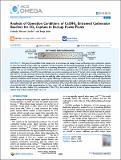Por favor, use este identificador para citar o enlazar a este item:
http://hdl.handle.net/10261/281290COMPARTIR / EXPORTAR:
 SHARE SHARE
 CORE
BASE CORE
BASE
|
|
| Visualizar otros formatos: MARC | Dublin Core | RDF | ORE | MODS | METS | DIDL | DATACITE | |

| Título: | Analysis of Operation Conditions of Ca(OH)2 Entrained Carbonator Reactors for CO2 Capture in Backup Power Plants |
Autor: | Álvarez Criado, Yolanda CSIC ORCID ; Arias Rozada, Borja CSIC ORCID | Fecha de publicación: | 16-ago-2022 | Editor: | American Chemical Society | Citación: | ACS Omega 7(32): 28093–28100 (2022) | Resumen: | The share of renewables in the energy sector is increasing, and energy storage and backup power combustion systems to cover the periods of time with low renewable energy production are becoming increasingly needed. Flexible calcium looping configurations based on the storage of solids are a promising alternative to capture the CO2 produced in such backup combustion systems. The use of Ca(OH)2 instead of CaO is better suited to these applications due to the faster reaction kinetics and higher carbonation conversions as Ca(OH)2 in powder form can achieve conversions of up to 0.7 in just a few seconds at temperatures of 550-650 °C. To take advantage of these fast reaction kinetics, compact carbonator reactors with short gas-solid contact times (i.e., a few seconds) can be designed. However, the low enthalpy of the carbonation reaction of Ca(OH)2 makes it challenging to find the optimum conditions which maximize the CO2 capture efficiency. In this work, a basic entrained reactor with recent experimental reaction kinetics has been used to determine suitable operational windows for this kind of carbonator. CO2 capture efficiencies above 90% can be achieved for flue gases with low CO2 concentrations (4%v CO2) when they are fed into the carbonator at temperatures of around 500-600 °C while maintaining low F Ca/F CO2 ratios (<2) and feeding the sorbent at ambient temperature. When capturing from a flue gas with a higher CO2 concentration (14%v CO2), the sorbent needs to be fed at higher temperatures to effectively capture CO2 in short contact times (i.e., 6 s). | Versión del editor: | https://doi.org/10.1021/acsomega.2c02134 | URI: | http://hdl.handle.net/10261/281290 | DOI: | 10.1021/acsomega.2c02134 | E-ISSN: | 2470-1343 |
| Aparece en las colecciones: | (INCAR) Artículos |
Ficheros en este ítem:
| Fichero | Descripción | Tamaño | Formato | |
|---|---|---|---|---|
| acsomega.2c02134_Criado.pdf | 2,87 MB | Adobe PDF |  Visualizar/Abrir |
CORE Recommender
SCOPUSTM
Citations
2
checked on 02-may-2024
WEB OF SCIENCETM
Citations
1
checked on 25-feb-2024
Page view(s)
29
checked on 07-may-2024
Download(s)
76
checked on 07-may-2024
Google ScholarTM
Check
Altmetric
Altmetric
Este item está licenciado bajo una Licencia Creative Commons

